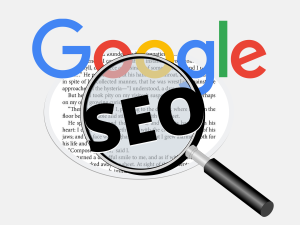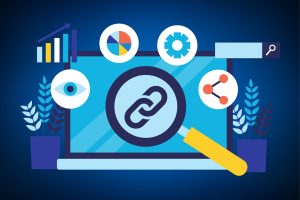Have you been posting consistently, but your blog is nowhere to be found? Are your contents educating, yet your website don’t have enough traffic? Or you don’t even know how to get traffic to your website? It can be so frustrating, getting educating and valuable contents out consistently without having an audience to check them out. Have you heard about SEO? If no, read this article till the end and discover ways to generate organic traffic to your website.

TABLE OF CONTENTS.
As you proceed, the following are what you should expect from this article
- What is SEO?
- Importance of SEO.
- Classification of SEO.
- What are backlinks?
- Why should you use backlinks?
- Types of backlinks.
- Not all backlinks are created equal.
- How to build high-quality backlinks.
- Black hat Vs White hat backlink building
- Risks of black hat SEO.
- Some penalties of Black hat SEO technique.
- Conclusion,
WHAT IS SEO?
When writing, SEO serves as a tool that helps you search trending keywords and how well the keywords rank. It can be likened to a vote of confidentiality. SEO (Search Engine Optimization) has been accepted over time by writers to be an important tool. Even for websites, SEO functions as the algorithm. No website can stand on its own without a strong backbone. That backbone is SEO. Good SEO is paying attention to the details most bloggers ignore.
IMPORTANCE OF SEO.
The use of the trending keywords found with the use of SEO helps websites and blogs to
- Rank on search engines
- Gain visibility
- Fasten the search of topics by users
- Relieve the stress of finding factual information.
CLASSIFICATION OF SEO.
While SEO is important for both users and websites or pages, it is a broad field with several tools that satisfies the needs of blogs, websites and users alike. These tools are classified into:
- Technical SEO: This deals with optimizing the technical aspects of the website. This aspect of SEO covers the creation of the website, making the website easily accessible, navigation, internal linking on the website, structured data and many more.

- On-site SEO: Here, the contents for a website are optimized for users and search engines. On-site SEO is concerned with quality contents that contains keywords, but not in excess. Excessive keywords alerts the search engine bots and makes the website available for more reviews. The goal is to publish quality content that is readable by users and contain keywords for easy access.
- Off-site SEO: This aspect is concerned with creating brand assets and doing things that will create brand awareness and increase visibility. You can think of this part of SEO as how well your website is talked about (reviews) and referred to other users. This, in SEO, is Link Building. Link Building is the process of acquiring links to the website. These links enable other website owners to be able to refer to your website.

From the above, it has been established that while technical SEO deals with users’ experience, off-site SEO deals with website reputation. Going forward, the website is considered a brand for easy understanding. Just like a physical brand, the website as a brand should have a reputation. This reputation is built to increase the brand’s visibility, awareness, recommendations and credibility in the eyes of search engines such as Google and Binge.
However, the off-site SEO has elements that play a crucial role in building your website reputation, making it an authority. These elements determine your website’s ranking in search engine results pages (SERPs).
Some important off-site SEO ranking factors that can significantly impact your website’s performance includes:
- Backlinks
- Social Media Engagement
- Online Directory Listings (ODL)
- Brand Mentions and Citations
- Customer Reviews and Ratings
In this article, our main focus is backlink which is an important component of off-site or off-page SEO.
WHAT ARE BACKLINKS?
Backlinks are links from external websites that leads to your site when clicked. If you enjoyed a product (physical or digital service) you purchased, you would like your friend to try it out, won’t you? You might choose to share their contact or refer them through social media. The act of referring your friends to your preferred or favored vendor is similar to the use of backlinks.
WHY SHOULD YOU USE BACKLINKS?
Remember how often you receive referrals from your friends and customers, how elated you feel when your brand is being referred and preferred to other brands. Backlinks stand as the bridge between your website and audience. It is more like a vote of confidentiality, solidifying your website in the minds of your audience. Backlinks help your website to:
- Stand out in the crowded marketplace
- Demonstrate to search engines like Google that your website has authority, especially if other high authority domains are linking to it
- It ensures your website success in SERPs
- The more high quality backlinks you obtain, the higher you rank on search engines
- It helps your website earn more web traffic.
- It improves visibility of your website
- It can also boost your domain authority.
These, among others, are the benefits of backlinks .
TYPES OF BACKLINKS.
There are several types of BACKLINKS, and they can be classified
- By their link building process:
Each of the backlink that is listed below has its own strength and weakness and it is important to understand how they work for an effective link building plan.
- Organic Backlinks:
This can be likened to referral by a fellow vendor. An organic backlink is a link placed by a real person on their website. This can be because its contents are beneficial for their audience and it adds value to their website. The primary way to get natural and relevant Backlinks to your website is to create valuable, timeless and vital contents that would attract other website creators.
- Guest Post Links: This can be likened to referral made by your customers or clients. Here, you have to find the people behind the websites that are relevant to your brand. One of the most common requirements is that your backlink provides or ad value to the article without being promotional.
- Private Blog Network (PBN) Backlinks: PBN Backlinks are links built from a network of interlinked websites that are often owned by a single pillar website. This backlink type, however, is not as popular today, but some SEOs still use it. The main purpose of utilizing a PBN, which provides complete control, is to increase the website’s authority.
Other types of backlinks in this category includes: Backlinks from forums and Q&A websites, press release links, among others.
- By or link attribute:
This backlink type is based on the attribute rel=”. This attribute helps Google to analyze the backlink and classify it either as sponsored, nofollow or user generated. The links under this category includes:
- Dofollow links: A dofollow or followed link is a regular link. As you can see, there’s nothing like rel=”dofollow” in the code because it is the default behavior and does not require specification.
- Nofollow links: They are links with an HTML tag of rel=”nofollow”, which instructs search engines not to the link or pass any link juice or page rank to the website.
Other types of links in this category are sponsored links and user-generated links.
- By page position: The placement of a backlink can impact it’s SEO’s value, whether it’s in the text, image, footer, header or widget. Types of backlinks in this category includes:
- Links in text content: This is the most common and most natural way for a backlink to be located. The texts surrounding such link, makes it the best way to get a backlink in terms of SEO as the surrounding texts provides additional context that is supplementary to the link. However, you must ensure that the texts surrounding the link is relevant.
- Links inside images: Occasionally, SEOs use images as links. You must have come across clickable banners in the sidebar, header or in the middle of the page. These can also be in the form of a linked image located somewhere in the text. However, text links tend to perform better than image links.
Other types of backlinks in this category are links in the widget, links in the footer and links in the header.
- By link cost: All backlinks can be divided into free, paid and acquired through exchange.
- Free links: These are links you get for free. The main category of free links is organic links, guest posting where you literally pay nothing. However, guest posting requires an investment in good and quality contents. Free links are usually considered a white SEO practice.
- Paid links: Many marketing and SEO specialists may consider aquiring some of their backlinks through monetary compensation because building links can be a long and tedious process. However, paying for backlinks is considered a violation of Google’s guidelines, as it is seen as an attempt to manipulate search engine rankings.
- Links received in exchange for a service: As part of a mutually beneficial agreement, some companies get backlinks in exchange for services such as server hosting, web design and others.

NOT ALL BACKLINKS ARE CREATED EQUAL.
The three essential elements of an effective SEO are effective communication, useful information and high quality backlinks. This brings us to the two main categories of backlinks which are high-quality backlinks and low-quality backlinks.
- HIGH-QUALITY BACKLINKS: These backlinks are highly authorative and relevant. They are natural and gotten from a reputable sources and can bring valuable traffic to your website. This is like having your business recommended by highly respected people.
- LOW-QUALITY BACKLINKS: They are bad backlinks that are irrelevant to the purpose of your website. They are often obtained through manipulative tricks causing high risks to your website.
If you’re asked to choose between a dose of an highly effective drug and 10 doses of the least effective one of the same brand, which would you choose? Considering the pain and inconvenience, in that moment, you would likely go for the highly effective drug. This is to further ascertain that the quality of a product is more preferred to its quantity. This should always be at the back of your mind when you’re sourcing for backlinks. Always go for the high-quality backlink as it reduces the risk of spammy websites.
HOW TO BUILD HIGH-QUALITY BACKLINKS.
You can say that it is going to be a long walk to build quality backlinks, but it definitely worth it. You can get quality backlinks by
- Creating valuable and readable contents that is relevant to your niche.
- Distribute contents through established blogger relationships.
- Become a source for reporters and bloggers.
- Earn links by ranking for statistical keywords.
- Link building with podcast websites.
- Update old contents.
- Publish ultimate guides.
- Get contextual links.
- Reach out to journalists.
- Guest blogging on relevant websites.

BLACK HAT AND WHITE HAT BACKLINK BUILDING
While black hat is more about hacking websites and risking its validation, white hat is more about creating value for the users of a website. Black hat SEO tactics includes keyword stuffing, bad paid links ,hidden content, publishing bad content, link farming or link trading, manipulating google and other search engines’ algorithm, amongst others. White hat SEO tactics includes on-page SEO optimization of the pages, off-page SEO optimization of the pages, creating high quality contents, guest post outreach to relevant websites, establishing backlinks to relevant and authorative websites, amongst others.
RISKS OF BLACK HAT SEO TECHNIQUES
Using black hat techniques is very risky and can impact your website negatively. The risks include
Algorithm Updates: Google is constantly tweaking and upgrading its algorithm to improve search results and manipulative SEO tactics. This upgrade is focused on tactics such as buying links, using spammy practices or publishing bad contents.
Manual Penalties: The use of black hat SEO techniques can lead to manual penalties imposed by search engines such as Google. Human viewers reports websites using black hat techniques and indicates that a site has violated search engine guidelines.
SOME PENALTIES FOR BLACK HAT SEO TECHNIQUES
- Damage to brand reputation
- Penalty and De-indexing
- Instability and unsustainability
- Loss of credibility
- Ethical concerns
These are some and not all of the penalties. It is advised to practice white hat SEO for your brand reputation and website safety.
CONCLUSION.
Since you’ve learned about SEO, backlinks and its types, you will agree that it is right to play safe without taking unnecessary risks by indulging in practices that are not safe for your brand and website. Endeavour to build backlinks the right way, seek organic traffic and indulge in only white hat SEO techniques.
